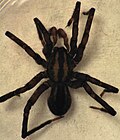The Haplogynae or haplogynes are one of the two main groups into which araneomorph spiders have traditionally been divided, the other being the Entelegynae...
10 KB (792 words) - 10:38, 3 December 2023
Haplogynae; others place the Austrochiloidea between the Haplogynae and the Entelegynae; the Hypochiloidea have also been grouped with the Haplogynae...
34 KB (2,202 words) - 00:02, 17 September 2024
Neocribellatae were in turn divided into the Austrochiloidea, and the two series Haplogynae and Entelogynae, each containing several superfamilies. Molecular phylogenetic...
16 KB (607 words) - 04:01, 13 October 2024
Dupérré (2009). A new genus of the spider family Caponiidae (Araneae, Haplogynae) from Iran. American Museum Novitates, 3656 :1-12. [1] Platnick, N.I....
8 KB (850 words) - 03:11, 23 January 2024
D. & Santos, A.J. (2017), "Phylogeny of Sicariidae spiders (Araneae: Haplogynae), with a monograph on Neotropical Sicarius", Zoological Journal of the...
3 KB (234 words) - 15:02, 25 March 2024
(10 June 1993). "A New Genus of the Spider Family Caponiidae (Araneae, Haplogynae) from California" (PDF). American Museum Novitates (3063): 1. Retrieved...
9 KB (1,050 words) - 16:46, 10 August 2024
features of the male and female genitalia, the family was placed in the Haplogynae, usually as the sister taxon of the remaining members of the group. However...
9 KB (904 words) - 20:29, 23 August 2023
captivity for over five seasons without any food at all. As part of the haplogynae, brown recluses do not balloon, which limits their ability to widely disperse...
44 KB (4,748 words) - 00:38, 14 October 2024
studies. The position of the clade relative to two much larger groups, Haplogynae and Entelegynae, has varied. A summary in 2005 showed the Austrochiloidea...
4 KB (312 words) - 09:22, 20 August 2021









